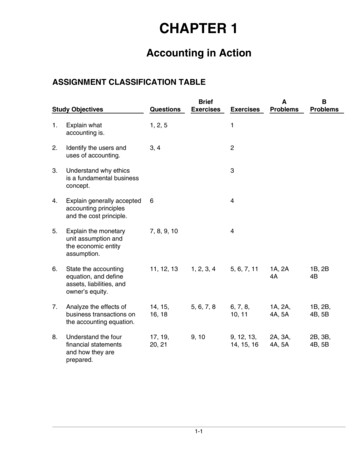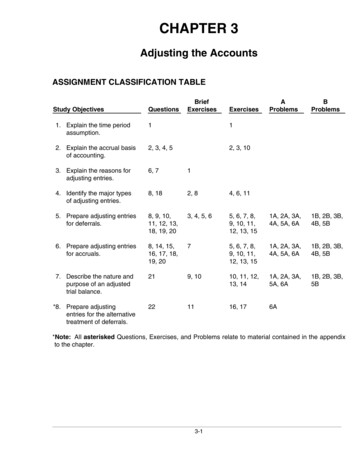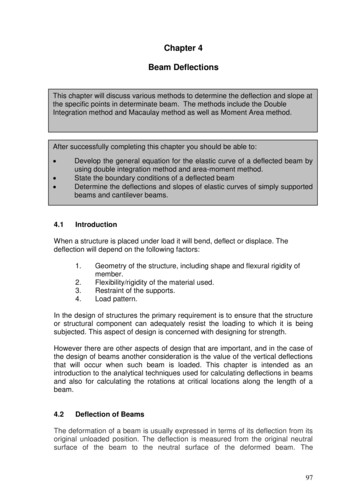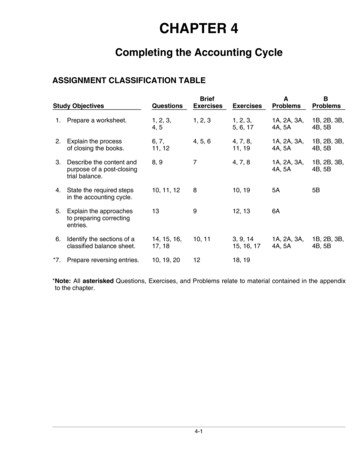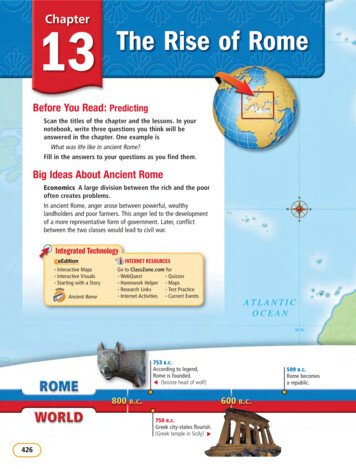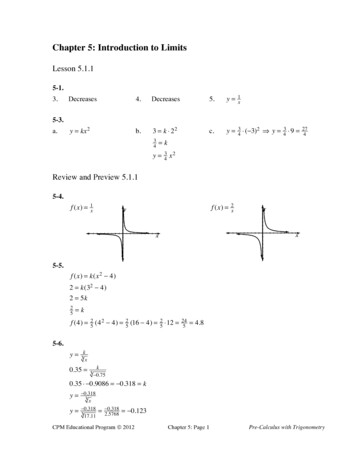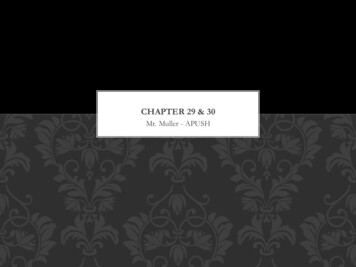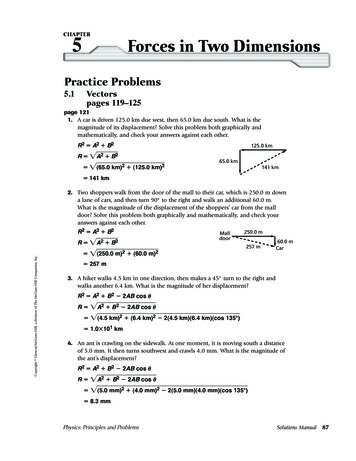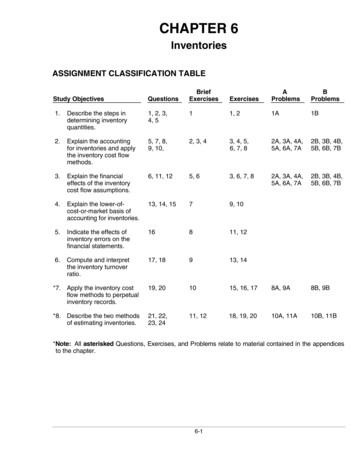
Transcription
CHAPTER 6InventoriesASSIGNMENT CLASSIFICATION TABLEBriefExercisesExercisesAProblemsBProblems1, 2, 3,4, 511, 21A1BExplain the accountingfor inventories and applythe inventory cost flowmethods.5, 7, 8,9, 10,2, 3, 43, 4, 5,6, 7, 82A, 3A, 4A,5A, 6A, 7A2B, 3B, 4B,5B, 6B, 7B3.Explain the financialeffects of the inventorycost flow assumptions.6, 11, 125, 63, 6, 7, 82A, 3A, 4A,5A, 6A, 7A2B, 3B, 4B,5B, 6B, 7B4.Explain the lower-ofcost-or-market basis ofaccounting for inventories.13, 14, 1579, 105.Indicate the effects ofinventory errors on thefinancial statements.16811, 126.Compute and interpretthe inventory turnoverratio.17, 18913, 14*7. Apply the inventory costflow methods to perpetualinventory records.19, 201015, 16, 178A, 9A8B, 9B*8. Describe the two methodsof estimating inventories.21, 22,23, 2411, 1218, 19, 2010A, 11A10B, 11BStudy ObjectivesQuestions1.Describe the steps indetermining inventoryquantities.2.*Note: All asterisked Questions, Exercises, and Problems relate to material contained in the appendicesto the chapter.6-1
ASSIGNMENT CHARACTERISTICS TABLEProblemNumberDescriptionDifficultyLevelTime Allotted(min.)1ADetermine items and amounts to be recorded in inventory.Moderate15–202ADetermine cost of goods sold and ending inventory usingFIFO, LIFO, and average-cost with analysis.Simple30–403ADetermine cost of goods sold and ending inventory usingFIFO, LIFO, and average-cost with analysis.Simple30–404ACompute ending inventory, prepare income statements,and answer questions using FIFO and LIFO.Moderate30–405ACalculate ending inventory, cost of goods sold, gross profit,and gross profit rate under periodic method; compareresults.Moderate30–406ACompare specific identification, FIFO, and LIFO underperiodic method; use cost flow assumption to influenceearnings.Moderate20–307ACompute ending inventory, prepare income statements,and answer questions using FIFO and LIFO.Moderate30–40*8ACalculate cost of goods sold and ending inventory forFIFO, average-cost, and LIFO, under the perpetualsystem; compare gross profit under each assumption.Moderate30–40*9ADetermine ending inventory under a perpetual inventorysystem.Moderate40–50*10AEstimate inventory loss using gross profit method.Moderate30–40*11ACompute ending inventory using retail method.Moderate20–301BDetermine items and amounts to be recorded in inventory.Moderate15–202BDetermine cost of goods sold and ending inventory usingFIFO, LIFO, and average-cost with analysis.Simple30–403BDetermine cost of goods sold and ending inventory usingFIFO, LIFO, and average-cost with analysis.Simple30–404BCompute ending inventory, prepare income statements,and answer questions using FIFO and LIFO.Moderate30–405BCalculate ending inventory, cost of goods sold, gross profit,and gross profit rate under periodic method; compareresults.Moderate30–406BCompare specific identification, FIFO, and LIFO underperiodic method; use cost flow assumption to justifyprice increase.Moderate20–306-2
ASSIGNMENT CHARACTERISTICS TABLE (Continued)ProblemNumberDifficultyLevelTime Allotted(min.)Compute ending inventory, prepare income statements,and answer questions using FIFO and LIFO.Moderate30–40*8BCalculate cost of goods sold and ending inventory underLIFO, FIFO, and average-cost, under the perpetual system;compare gross profit under each assumption.Moderate30–40*9BDetermine ending inventory under a perpetual inventorysystem.Moderate40–50*10BCompute gross profit rate and inventory loss using grossprofit method.Moderate30–40*11BCompute ending inventory using retail method.Moderate20–307BDescription6-3
6-4Explain the accounting forinventories and apply theinventory cost flow methods.Explain the financial effects of theinventory cost flow assumptions.Explain the lower-of-cost-or-marketbasis of accounting for inventories.Indicate the effects of inventoryerrors on the financial statements.Compute and interpret the inventoryturnover ratio.Apply the inventory cost flowmethods to perpetual inventoryrecords.Describe the two methods ofestimating inventories.2.3.4.5.6.*7.*8.Broadening Your PerspectiveDescribe the steps in determininginventory quantities.1.Study ObjectiveE6-18 P6-11AE6-19 P6-10BE6-20 ring theWebE6-14 Q6-18BE6-9Financial ReportingDecision MakingAcross -12All About YouEthics CaseComp. 16BE6-8E6-3P6-5AP6-5BP6-6AP6-6BP6-5B E6-3P6-6A P6-4AP6-6B 4 Q6-5BE6-1 Q6-2Knowledge ComprehensionCorrelation Chart between Bloom’s Taxonomy, Study Objectives and End-of-Chapter Exercises and ProblemsBLOOM’S TAXONOMY TABLE
ANSWERS TO QUESTIONS1.Agree. Effective inventory management is frequently the key to successful business operations.Management attempts to maintain sufficient quantities and types of goods to meet expectedcustomer demand. It also seeks to avoid the cost of carrying inventories that are clearly in excessof anticipated sales.2.Inventory items have two common characteristics: (1) they are owned by the company and (2) theyare in a form ready for sale in the ordinary course of business.3.Taking a physical inventory involves actually counting, weighing or measuring each kind ofinventory on hand. Retailers, such as a hardware store, generally have thousands of differentitems to count. This is normally done when the store is closed.4.(a) (1)5.Inventoriable costs are 3,020 (invoice cost 3,000 freight charges 50 – purchase discounts 30). The amount paid to negotiate the purchase is a buying cost that normally is not included inthe cost of inventory because of the difficulty of allocating these costs. Buying costs areexpensed in the year incurred.6.There are three distinguishing features in the income statement of a merchandising company:(1) a sales revenues section, (2) a cost of goods sold section, and (3) gross profit.7.Actual physical flow may be impractical because many items are indistinguishable from oneanother. Actual physical flow may be inappropriate because management may be able tomanipulate net income through specific identification of items sold.8.The major advantage of the specific identification method is that it tracks the actual physical flowof the goods available for sale. The major disadvantage is that management could manipulatenet income.9.No. Selection of an inventory costing method is a management decision. However, once a methodhas been chosen, it should be consistently applied.The goods will be included in Reeves Company’s inventory if the terms of sale areFOB destination.(2) They will be included in Cox Company’s inventory if the terms of sale are FOB shippingpoint.(b) Reeves Company should include goods shipped to a consignee in its inventory. Goods heldby Reeves Company on consignment should not be included in inventory.10.(a) FIFO.(b) Average-cost.(c) LIFO.11.Plato Company is using the FIFO method of inventory costing, and Cecil Company is using theLIFO method. Under FIFO, the latest goods purchased remain in inventory. Thus, the inventoryon the balance sheet should be close to current costs. The reverse is true of the LIFO method.Plato Company will have the higher gross profit because cost of goods sold will include a higherproportion of goods purchased at earlier (lower) costs.6-5
Questions Chapter 6 (Continued)12. Casey Company may experience severe cash shortages if this policy continues. All of its netincome is being paid out as dividends, yet some of the earnings must be reinvested in inventoryto maintain inventory levels. Some earnings must be reinvested because net income iscomputed with cost of goods sold based on older, lower costs while the inventory must bereplaced at current, higher costs. Because of this factor, net income under FIFO is sometimesreferred to as “phantom profits.”13. Peter should know the following:(a) A departure from the cost basis of accounting for inventories is justified when the value ofthe goods is lower than its cost. The writedown to market should be recognized in the periodin which the price decline occurs.(b) Market means current replacement cost, not selling price. For a merchandising company,market is the cost at the present time from the usual suppliers in the usual quantities.14. Garitson Music Center should report the CD players at 380 each for a total of 1,900. 380is the current replacement cost under the lower-of-cost-or-market basis of accounting for inventories.A decline in replacement cost usually leads to a decline in the selling price of the item. Valuationat LCM is conservative.15. Ruthie Stores should report the toasters at 27 each for a total of 540. The 27 is the lower of costor market. It is used because it is the lower of the inventory’s cost and current replacement cost.16. (a) Mintz Company’s 2007 net income will be understated 7,000; (b) 2008 net income will beoverstated 7,000; and (c) the combined net income for the two years will be correct.17. Willingham Company should disclose: (1) the major inventory classifications, (2) the basis ofaccounting (cost or lower of cost or market), and (3) the costing method (FIFO, LIFO, or average).18. An inventory turnover that is too high may indicate that the company is losing sales opportunitiesbecause of inventory shortages. Inventory outages may also cause customer ill will and result inlost future sales.*19. Disagree. The results under the FIFO method are the same but the results under the LIFOmethod are different. The reason is that the pool of inventoriable costs (cost of goods availablefor sale) is not the same. Under a periodic system, the pool of costs is the goods available forsale for the entire period, whereas under a perpetual system, the pool is the goods available forsale up to the date of sale.*20. In a periodic system, the average is a weighted average based on total goods available for sale for theperiod. In a perpetual system, the average is a moving average of goods available for sale aftereach purchase.*21. Inventories must be estimated when: (1) management wants monthly or quarterly financialstatements but a physical inventory is only taken annually and (2) a fire or other type of casualtymakes it impossible to take a physical inventory.6-6
Questions Chapter 6 (Continued)*22. In the gross profit method, the average is the gross profit rate, which is gross profit divided by netsales. The rate is often based on last year’s actual rate. The gross profit rate is applied to net salesin using the gross profit method.In the retail inventory method, the average is the cost-to-retail ratio, which is the goods availablefor sale at cost divided by the goods available for sale at retail. The ratio is based on current yeardata and is applied to the ending inventory at retail.*23. The estimated cost of the ending inventory is 40,000:Net sales .Less: Gross profit ( 400,000 X 35%) .Estimated cost of goods sold . 400,000140,000 260,000Cost of goods available for sale .Less: Cost of goods sold.Estimated cost of ending inventory. 300,000260,000 40,000*24. The estimated cost of the ending inventory is 28,000: 84,000 120,000 Cost-to-retail ratio:70% Ending inventory at retail: 40,000 ( 120,000 – 80,000)Ending inventory at cost: 28,000 ( 40,000 X 70%)6-7
SOLUTIONS TO BRIEF EXERCISESBRIEF EXERCISE 6-1(a) Ownership of the goods belongs to the consignor (Smart). Thus, thesegoods should be included in Smart’s inventory.(b) The goods in transit should not be included in the inventory countbecause ownership by Smart does not occur until the goods reachthe buyer.(c) The goods being held belong to the customer. They should not beincluded in Smart’s inventory.(d) Ownership of these goods rests with the other company (the consignor).Thus, these goods should not be included in the physical inventory.BRIEF EXERCISE 6-2The items that should be included in inventoriable costs are:(a)(b)(c)(e)Freight-inPurchase Returns and AllowancesPurchasesPurchase DiscountsBRIEF EXERCISE 6-3(a) The ending inventory under FIFO consists of 200 units at 8 160 unitsat 7 for a total allocation of 2,720 or ( 1,600 1,120).(b) The ending inventory under LIFO consists of 300 units at 6 60 unitsat 7 for a total allocation of 2,220 or ( 1,800 420).6-8
BRIEF EXERCISE 6-4Average unit cost is 6.89 computed as follows:300 X 6 1,800400 X 7 2,800200 X 8 1,600900 6,200 6,200 900 6.89 (rounded).The cost of the ending inventory is 2,480 or (360 X 6.89).BRIEF EXERCISE 6-5(a)(b)(c)(d)FIFO would result in the highest net income.FIFO would result in the highest ending inventory.LIFO would result in the lowest income tax expense (because it wouldresult in the lowest net income).Average-cost would result in the most stable income over a numberof years because it averages out any big changes in the cost of inventory.BRIEF EXERCISE 6-6Cost of good sold under:PurchasesCost of goods available for saleLess: Ending inventoryCost of goods soldLIFO 6 X 100 7 X 200 8 X 150 3,200 1,160 2,040FIFO
6-6 Questions Chapter 6 (Continued) 12. Casey Company may experience severe cash shortages if this policy continues. All of its net income is being paid out as dividends, yet some of the earnings must be reinvested in inventory

